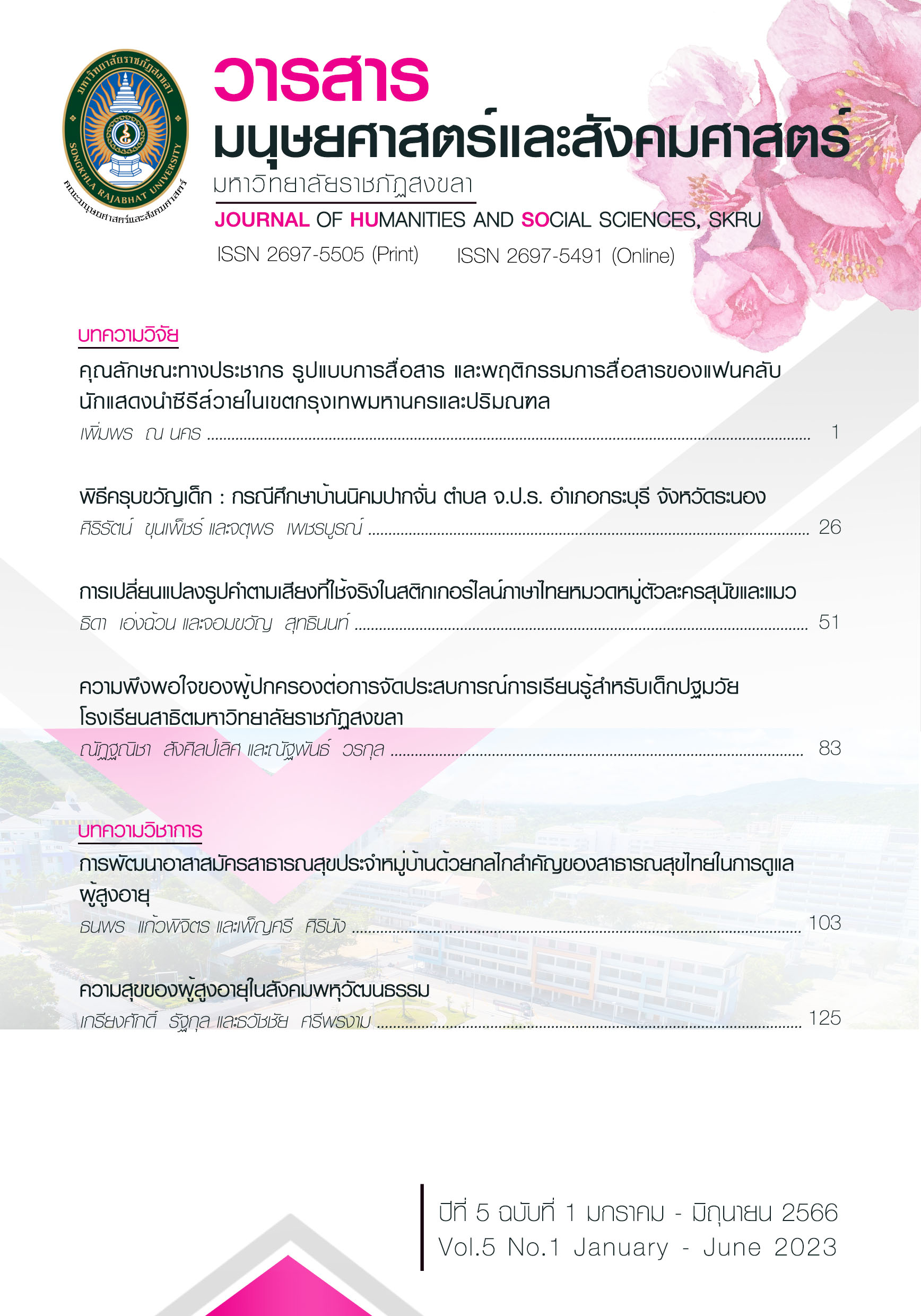THE DEMOGRAPHIC CHARACTERISTICS, TYPES OF COMMUNICATION AND COMMUNICATION BEHAVIOR OF FANS FOR Y SERIES ACTORS IN BANGKOK AND PERIMETER
Main Article Content
Abstract
This research is a study of demographic characteristics, types of communication, communication behavior, the difference of characteristics’ fans and relationship between behavior of fans with types of communication of fans for Y series actors in Bangkok and the perimeter. This quantitative research applies an online questionnaire with 400 participants selected by using a purposive sampling technique, and the quota sampling from 4 online platforms, namely Line, Facebook, Twitter and Instagram. The data were analyzed by using descriptive statistics and inferential statistics. The results shows that the demographic characteristics of the Y series actor’s fans in Bangkok and the perimeter in terms of gender, education, income, occupation and length of contact with the Y series actors has different effects on the communication behavior of the participants, except for the different level of the participants’ education which has no difference in their communication behavior. Various forms of communication including intrapersonal, interpersonal, online and mass communication affect to the participants’ preferences and lead to communication behavior, namely supporting, recognition, willingness, and loyalty.
Downloads
Article Details

This work is licensed under a Creative Commons Attribution-NonCommercial-NoDerivatives 4.0 International License.
ลิขสิทธิ
References
ชนะใจ ต้นไทรทอง, เกิดศิริ เจริญวิศาล และมนัสสินี บุญมีศรีสง่า. (2564). “อิทธิพลความเกี่ยวพันของดารากับแฟนคลับชาวไทยที่ส่งผ่านการตอบสนองทางอารมณ์สู่พฤติกรรมการท่องเที่ยว”. วารสารมนุษยศาสตร์และสังคมศาสตร์ มหาวิทยาลัยอุบลราชธานี. 12(2), 144-163.
ทักษญา หมอกบัว. (2563). พฤติกรรมการเปิดรับสื่อที่มีผลต่อความชื่นชอบซีรี่ส์วายเรื่องเพราะเราคู่กันของเยาวชนในเขตกรุงเทพมหานคร. วิทยานิพนธ์ปริญญามหาบัณฑิต สาขาการสื่อสารเชิงกลยุทธ์ คณะนิเทศศาสตรมหาบัณฑิต. มหาวิทยาลัยกรุงเทพ. กรุงเทพฯ.
พฤกษา จันทร์ประทีป. (2559). วิถีของแฟนคลับดารา (Life of Fans). วิทยานิพนธ์ปริญญามหาบัณฑิต สาขาทัศนศิลป์ คณะจิตรกรรม. มหาวิทยาลัยศิลปากร. กรุงเทพฯ.
ณัฐธนนท์ ศุขถุงทอง และภูวิน บุณยะเวชชีวิน. (2561). “ซีรีส์วาย: ข้อพิจารณาเบื้องต้นทางสถิติ”. International Journal of East Asian Stusies, 23(2), 360-383.
เพิ่มพร ณ นคร และณัฏฐ์วัฒน์ ธนพรรณสิน. (2565). “รูปแบบการสื่อสารของแฟนคลับนักแสดงซีรีส์โทรทัศน์ไทยแนวชายรักชาย”. วารสารการสื่อสารมวลชน คณะการสื่อสารมวลชน มหาวิทยาลัยเชียงใหม่. 10(1), 355-380.
วรุตม์ มีทิพย์. (2560). ปัจจัยที่ส่งผลกระทบต่อความซื่อสัตย์ภักดีต่อศิลปินเกาหลีของกลุ่มแฟนคลับชาวไทยในเขตกรุงเทพมหานคร. วิทยานิพนธ์ปริญญามหาบัณฑิต สาขาการสื่อสารเชิงกลยุทธ นิเทศศาสตรมหาบัณฑิต. มหาวิทยาลัยกรุงเทพ. กรุงเทพฯ.
ศรัณย์ สิงห์ทน. (2552). การเรียนรู้ทางสังคมของวัยรุ่นไทยจากวัฒนธรรมเพลงสมัยใหม่ของประเทศเกาหลีใต้. วิทยานิพนธ์ปริญญาดุษฎีบัณฑิต สาขาสื่อสารมวลชน คณะวารสารศาสตร์และสื่อสารมวลชน มหาวิทยาลัยธรรมศาสตร์. กรุงเทพฯ.
สุพรรณรัตน์ มนต์วิเศษ. (2560). “การรับรู้ภาพลักษณ์ดารายอดนิยมในประเทศไทยผ่านสื่อสังคมออนไลน์ของกลุ่มเจนเนอเรชั่นวาย”. วารสารการสื่อสารและการจัดการ นิด้า. 3(1), 79-87.
ภัทรนันท์ หนุนภักดี. (2550). แฟนคลับ: กระบวนการกลุ่มและพฤติกรรมสมาชิก. วิทยานิพนธ์ปริญญามหาบัณฑิต สาขาศิลปศาสตร์ สาขาสังคมวิทยาประยุกต์ ภาควิชาสังคมวิทยาและมานุษวิทยา มหาวิทยาลัยเกษตรศาสตร์. กรุงเทพฯ.
ภัชรพรรณ์ อมรศรีวงษ์ และบัณฑิต สวรรยาวิสุทธ. (2562). “การศึกษาทัศนคติและพฤติกรรมการบริโภคสื่อของสาววาย”. วารสารรังสิตบัณฑิตศึกษาในกลุ่มธุรกิจและสังคมศาสตร์. 5(1), 34-49.
อภินันท์ จันตะนี. (2550). สถิติและการวิจัยทางธุรกิจ. กรุงเทพฯ:มหาวิทยาลัยราชภัฏพระนครศรีอยุธยา.
เอรินทร์ เผือกเกษม และพรทิพย์ สัมปัตตะวนิช. (2563). “ระดับความชื่นชอบไอดอลเกาหลีกับการตอบสนองต่อตราสินค้าของผู้บริโภค”. วารสารการประชาสัมพันธ์และการโฆษณา. 13(1), 127-140.
Backhouse, R., Bird, R., & Hoogendijk, P. (2009). “Meeting a fanclub: a lattice of generic shape selectors”. Proceedings of the 2009 ACM SIGPLAN workshop on Generic programming. Retrieved November, 24 2022, from https://doi.org/10.1145/1596614.1596625.
Jenkins, H. (1992). Textual Poachers. New York and London: Routleedge.
Roscoe, J. T. (1975). Fundamental Research Statistics for the Behavioral Sciences. New York: Holt Rinehart and Winston, Inc.
Stacks, D. W., Salwen, M. B., & Eichhorn, K. C. (Eds.). (2009). An integrated approach to communication theory and research. New York: Routledge.
Oles’, P. K., Brinthaupt, T. M., Dier, R., & Polak, D. (2020). “Types of inner dialogues and functions of self-talk: Comparisons and implications”. Frontiers in Psychology, 11, 227.


